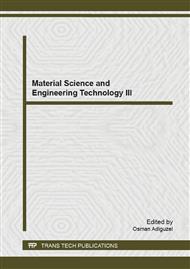[1]
X.Q. Cao, R. Vassen, D.C. Stoever, Materials for thermal barrier coatings, J. Eur. Ceram. Soc., 24(2004) 1-10.
Google Scholar
[2]
W. Guo, X. Qiao, Y. Huang, M. Fang, X. Han, Study on energy saving effect of heat-reflective insulation coating on envelopes in the hot summer and cold winter zone, Energy Buildings. 50 (2012) 196–203.
DOI: 10.1016/j.enbuild.2012.03.035
Google Scholar
[3]
T. Karlessi, M. Santamouris, A. Synnefa, D. Assimakopoulos, P. Didaskalopoulos, K. Apostolakis, Development and testing of PCM doped cool colored coatings to mitigate urban heat island and cool buildings, Build. Environ. 46(2011) 570–576.
DOI: 10.1016/j.buildenv.2010.09.003
Google Scholar
[4]
X. Yang and Y. Jiang, Comparison of building energy consumption data between China and developed countries, China Energy, 29(2007) 21-26.
Google Scholar
[5]
W. Zhang, Z. Song, Y. Shi, J. Song, J. Qu, J. Qin, T. Zhang, Y. Li, W. Ji, L. Xu, X. Xue, The effects of manufacturing processes and artificial accelerated weathering on the solar reflectance and cooling effect of cool roof coatings. Solar Energy Materials&Solar Cells. 118(2013).
DOI: 10.1016/j.solmat.2013.07.039
Google Scholar
[6]
R. Siegel, Thermal Radiation Heat Transfer, fifth ed, CRC Press, Florida, (2010).
Google Scholar
[7]
J. Qu, J.R. Song, J. Q, Z.N. Song, W.D. Zhang, Y.X. Shi, T. Zhang, H.Q. Zhang, R.P. Zhang, Z.Y. He and X. Xue, Transparent thermal insulation coatings for energy efficient glass windows and curtain walls, Energy Buildings. 77 (2014) 1–10.
DOI: 10.1016/j.enbuild.2014.03.032
Google Scholar
[8]
Z. Song, W. Zhang, Y. Shi, J. SONG, J. Qu, T. Zhang, Y. Li , H. Zhang, R. Zhang, Optical properties across the solar spectrum and indoor thermal performance of cool white coatings for building energy efficiency, Energy Buildings. 63 (2013) 49–58.
DOI: 10.1016/j.enbuild.2013.03.051
Google Scholar
[9]
X.F. Ye, L.Z. Cui, Y.H. Gao and Y.H. Yuan, Development of waterborne composite acrylic thermal insulation exterior wall coatings. Paint & Coating, 41 (2011) 51–53.
Google Scholar
[10]
X.F. Ye, D.C. Chen, Q.H. Liang, F.Y. Li and S.P. Liang,Preparation of the composite fluorocarbon thermal insulation coatings, Mod. Chem. Ind. 34 (2014) 90–92.
Google Scholar


